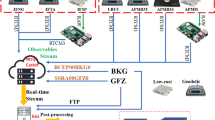Abstract
A paper published recently (Hogan et al. in Gen. Relativ. Gravit. 43:1953–2009, 2011) suggests the use of atom interferometry between satellites in Earth orbit to observe gravitational waves. The proposed altitude and satellite separation are about 1,000 and 30 km respectively. The difference in acceleration between clouds of ultracold atoms in atom interferometers near the two satellites would be detected by using laser beams between the interferometers. Because of the measurement path being very short compared with the million km or longer measurement path for a proposed laser interferometer gravitational wave antenna in space, the sensitivity to differential fluctuations in the laser phase as seen by the atoms in the two atom interferometers is very high. Problems introduced by this high sensitivity to spurious laser beam phase changes will be described in the first part of this paper. Then other limitations on the performance and on the suggested types of sources that could be observed will be discussed.
Similar content being viewed by others
References
Hogan J.M. et al.: Gen. Relativ. Gravit. 43, 1953–2009 (2011)
Dimopoulos S., Graham P.W., Hogan J.M., Kasevich M.A., Rajendran S.: Phys. Rev. D 78, 122002 (2008)
Bender P.L.: Phys. Rev. D 84, 028101 (2011)
Dimopoulos S. et al.: Phys. Rev. D 84, 028102 (2011)
Hopman C.: Class. Quantum Grav. 26, 094028 (2009)
Will C.M.: ApJ 611, 1080–1083 (2004)
Bender P.L., Hils D.: Class. Quantum Grav. 14, 1439–1444 (1997)
Hils D., Bender P.L., Webbink R.F.: ApJ 360, 75–94 (1990)
Timpano S.E., Rubbo L.J., Cornish N.J.: Phys. Rev. D 73, 122001 (2006)
Nelemans, G.: Astrophysics of white dwarf binaries. In: S. M. Merkowitz, J. C. Livas (eds.) Laser Interferometer Space Antenna, AIP Conf. Proc. 873, (Am. Inst. Physics, Melville, N.Y., 2006), pp. 397–405
Nelemans G., Yungelson L.R., Portegies Zwart S.F.: Astron. Astrophys. 375, 890–898 (2001)
Ruiter A.J., Belczynski K., Benacquista M., Holley-Bockelmann K.: Astrophys. J. 693, 383–387 (2009)
Nelemans G.: Class. Quantum Grav. 26, 094030 (2009)
Author information
Authors and Affiliations
Corresponding author
Rights and permissions
About this article
Cite this article
Bender, P.L. Limitations of atom interferometry for gravitational wave observations in space. Gen Relativ Gravit 44, 711–717 (2012). https://doi.org/10.1007/s10714-011-1306-3
Received:
Accepted:
Published:
Issue Date:
DOI: https://doi.org/10.1007/s10714-011-1306-3




